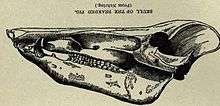Bornean bearded pig
| Bearded pig | |
|---|---|
| | |
| At the Hellabrunn Zoo (Munich) | |
 | |
| At the San Diego Zoo | |
| Scientific classification | |
| Kingdom: | Animalia |
| Phylum: | Chordata |
| Clade: | Synapsida |
| Class: | Mammalia |
| Order: | Artiodactyla |
| Family: | Suidae |
| Genus: | Sus |
| Species: | S. barbatus |
| Binomial name | |
| Sus barbatus Müller, 1838 | |
| Subspecies | |
|
Sus barbatus oi | |


The Bornean bearded pig (Sus barbatus), also known ambiguously as the bearded pig, is a species in the pig genus, Sus.[2]
It can be recognized by its prominent beard. It also sometimes has tassels on its tail. It is found in Southeast Asia—Sumatra, Borneo, the Malay Peninsula, and various smaller islands like in Sulu archipelago such as Tawi-Tawi, where it inhabits rainforests and mangrove forests. The bearded pig lives in a family. It can reproduce from the age of 18 months, and can be cross-bred with other species in the family Suidae. The San Diego Zoo was the first zoo in the Western Hemisphere to breed them. As of January 2016, it is held in the London Zoo, Berlin Zoo, Hellabrunn Zoo,[3] Gladys Porter Zoo, National Zoo of Malaysia (Zoo Negara), Zoo Taiping, Singapore Zoo, Capital of Texas Zoo, and Southwick's Zoo.[4]
Subspecies
The two subspecies of this pig are:[2]
- S. b. barbatus (the nominate subspecies)
- S. b. oi (the western bearded pig)
As traditionally defined, the nominate is from Borneo. The species is widely ranging in Borneo. It is also found in Tawi-Tawi province at the tip of the Sulu Archipelago in the Philippines, and S. b. oi is from the Malay Peninsula and Sumatra. Genetic evidence suggests this is incorrect, and S. b. oi is better limited to Sumatra, leaving bearded pigs from both Borneo and the Malay Peninsula in the nominate subspecies.[5] Those from Bangka Island appear somewhat intermediate between the two subspecies.[5]
The Palawan bearded pig (Sus ahoenobarbus) has formerly been considered a subspecies of the bearded pig. However, as indicated by its genetic and morphological distinctness, under the phylogenetic species concept (which does not use subspecies) it needs to be elevated to full species status; while the situation is less clear under other species concepts (as not all S. barbatus populations have been restudied in modern times), the presently available information seems to favor full species status for S. ahoenobarbus in any case.[5]
References
- ↑ Kawanishi, K.; Gumal, M. & Oliver, W. (2008). "Sus barbatus". IUCN Red List of Threatened Species. Version 2008. International Union for Conservation of Nature. Retrieved 5 April 2009. Database entry includes a brief justification of why this species is of vulnerable.
- 1 2 Grubb, P. (2005). Wilson, D.E.; Reeder, D.M., eds. Mammal Species of the World: A Taxonomic and Geographic Reference (3rd ed.). Johns Hopkins University Press. ISBN 978-0-8018-8221-0. OCLC 62265494.
- ↑ "Zootierliste Homepage". Retrieved 2016-11-28.
- ↑ ISIS (2011). Sus barbatus. Version 12 Jan 2011
- 1 2 3 Lucchini, Meijaard, Diong, Groves and Randi (2005). New phylogenetic perspectives among species of South-east Asian wild pig (Sus sp.) based on mtDNA sequences and morphometric data. J. Zool., Lond. 266: 25–35
External links
 Data related to Sus barbatus at Wikispecies
Data related to Sus barbatus at Wikispecies Media related to Sus barbatus at Wikimedia Commons
Media related to Sus barbatus at Wikimedia Commons- Groves, C. P. (1997). "Taxonomy of wild pigs (Sus) of the Philippines". Zoological Journal of the Linnean Society, 120: 163–191. doi: 10.1111/j.1096-3642.1997.tb01277.x Abstract (full article requires subscription access)
- Sus barbatus by Nicole Knibbe in University of Michigan Museum of Zoology
- Pigs, Peccaries and Hippos Status Survey and Action Plan (1993) Chapter 5.5 by Julian O. Caldecott, Raleigh A. Blouch and Alastair A. Macdonald.
